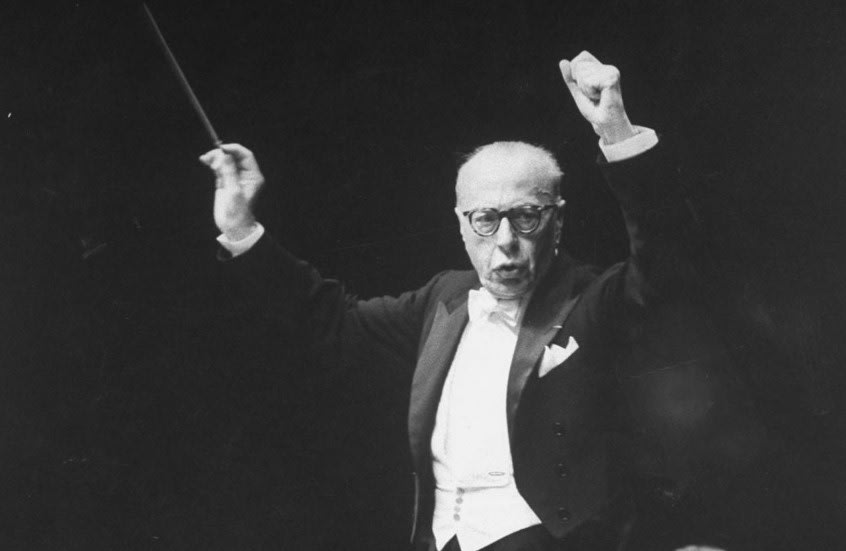
‘George Szell The Complete Columbia Album Collection’ Review A Maestro’s Time in Cleveland Still Shines
This 106-CD set assembles almost all of the conductor’s recordings with the Cleveland Orchestra, along with a few Szell made with the New York Philharmonic, the Columbia Symphony Orchestra, and as a remarkably vibrant chamber-music pianist.
By Allan Kozinn
Aug. 22, 2018
When George Szell died, in 1970, he was revered for having built the Cleveland Orchestra into one of the world’s great ensembles in a 24-year tenure that began in 1946, and as an interpreter whose streamlined but high-power readings were rooted in his belief that a composer’s intentions were sacrosanct. But though he played down the Romantic notion that interpretation should also reflect the performer’s personality, Szell’s readings were always identifiable by their structural logic, textural clarity, unerring balances and sheer energy. Under Szell’s baton, an orchestra was a highly polished, precision machine, and in music by Beethoven, Schubert, Brahms, Dvořák and Wagner, he was untouchable.
Yet, at the time of his death, the music world as Szell knew it was hurtling toward obsolescence. One of the last great podium martinets, Szell wielded absolute authority and executed it with severity—an approach that vanished once unions began asserting themselves in matters of how musicians should be treated. Vanished, too, is the kind of devotion Szell showed to the Cleveland Orchestra. These days, a tenure lasting nearly a quarter century is rare; beyond a decade, critics wonder (often abetted by off-the-record carping from the players) whether the relationship is growing stale.
Szell’s, with Cleveland, never did; the chemistry between them consistently yielded both heat and light. Their recordings for the Epic and CBS Masterworks labels, starting in 1947, were exemplary in their day, and they remain so now, a point Sony Classical makes vividly in its 106-CD “George Szell: The Complete Columbia Album Collection,” out now. Except for some live recordings issued by the orchestra itself, all of Szell’s Cleveland recordings are here, along with a few Szell made with the New York Philharmonic, the Columbia Symphony Orchestra, and as a remarkably vibrant chamber-music pianist. The discs are beautifully remastered, and packaged in sleeves that replicate their original artwork and liner notes, with period-correct labels and a hardcover book that provides all the recording details.
Mammoth boxes like this, which have become plentiful lately, are the last gasps of the physical record industry, intent on presenting its wares as they were in their heyday, one last time before streaming blows away the tactile side of music collecting entirely. They are comprehensive, relatively inexpensive (the Szell set can be had for less than $2 a disc) and provide the eerie sense that you are holding the full shape and substance of a great musician’s career in your hands.
The Szell box is a fascinating glimpse at how the supposedly ossified classical canon has evolved (albeit slowly) over the decades. There is, for example, very little Mahler or Bruckner, indispensable staples of a conducting career now. But what there is—most notably, a rich-hued 1966 Mahler Fourth Symphony, and a broad-boned 1970 Bruckner Eighth—stands up well to modern competition. It is also hard to imagine a conductor today recording 106 discs with only a handful devoted to contemporary music and, of that, only a single Stravinsky work, the “Firebird” Suite.
Yet when Szell considered a new work worth recording—for example, a spiky, high-contrast account of Samuel Barber’s Piano Concerto, with John Browning; or taut, colorful performances of Walton’s Partita for Orchestra and Symphony No. 2; or a curious reading of Bartók’s Concerto for Orchestra that begins sedately but eventually explodes from the speaker—he is an eloquent advocate, as focused on detail, balance and the subtleties of color as he is in the great Romantic works.
There are occasional disappointments that have more to do with changing interpretive fashion than with any deficiencies of Szell’s. His Mozart, Haydn and Bach, for example, sound a bit ponderous by today’s standards. And despite his reputation as a literalist, he often jettisoned exposition repeats, arguing in interviews (several are included in the set) that repeats were necessary only when works were new and audiences were unfamiliar with them.
Szell’s specialty was the Romantic repertory. His Beethoven and Brahms Symphonies remain among the most tightly reasoned and precisely executed on the market, and his collaborations on those composers’ piano concertos, with Leon Fleisher, are still the gold standard. It’s not easy to find a recording that captures the same level of urgency and anxiety Szell brought to Strauss’s “Death and Transfiguration,” and his Wagner Overtures are truly regal. Even pieces that, today, are typically curtain-raisers or encores—Rossini Overtures, the Dvořák “Slavonic Dances”—have an uncommon intensity that makes them sound like major statements.
Lately, the sweep of reductive history has elevated Arturo Toscanini, Leonard Bernstein and Herbert von Karajan to almost mythic status, leaving the other great conductors of the 20th century as footnotes that only specialist collectors care about. That’s not how it seemed at the time, of course. And the new Sony box is a reminder, disc for disc, that Szell deserves a place in that pantheon.
—Mr. Kozinn writes about music for the Journal.

(機械翻訳)

(機械翻訳)
「ジョージ・ゼル・ザ・コンプリート・コロンビア・アルバム・コレクション」レビュー・ア・マエストロの時間
この106枚のCDセットは、指揮者の録音のほとんどすべてをクリーブランド管弦楽団と組み合わせて、ニューヨーク・フィルハーモニー管弦楽団、コロンビア交響楽団、そして非常に活気に満ちた室内楽ピアニストとして作られたいくつかのゼルと一緒に組み立てます。
アラン・コジン 著
2018年8月22日
ジョージ・ゼルが亡くなったとき、1970年にクリーブランド管弦楽団を1946年に始まった24年間の在任中に世界の偉大なアンサンブルの一つに組み込み、合理化されたが高出力の読書が作曲家の意図はサクロサンクトであるという彼の信念に根ざした通訳として尊敬されました。しかし、彼は解釈もパフォーマーの性格を反映すべきであるというロマンチックな考えを演じたが、Szellの読書は常に彼らの構造的論理、テクスチャの明快さ、絶え間ないバランスと完全なエネルギーによって識別可能でした。ゼルのバトンの下では、オーケストラは非常に洗練された精密なマシンであり、ベートーヴェン、シューベルト、ブラームス、ドヴォルザーク、ワーグナーの音楽では、彼は手つかずでした。
しかし、彼の死の時、Szellとしての音楽の世界は、それが陳腐化に向かって傷ついていることを知っていました。最後の偉大な表彰台のマルティネットの一つであるSzellは絶対的な権威を振り回し、重症度でそれを実行しました。消えたのも、Szellがクリーブランド管弦楽団に見せたような献身です。最近では、四半世紀近く続くテニュアはまれです。10年を超えて、批評家は関係が古くなっているかどうか疑問に思う(多くの場合、選手からのオフレコードカーピングによって賭け)。
ゼルは、クリーブランドと一緒に、決してしませんでした。それらの間の化学は一貫して熱と光の両方を生み出した。1947年から始まったエピックとCBSマスターワークスのレーベルの録音は、その日の模範的なもので、ソニー・クラシックが106枚のCD「ジョージ・ゼル:完全なコロンビア・アルバム・コレクション」で生き生きと作るポイントです。オーケストラ自身が発行したライブ録音を除いて、ゼルのクリーブランドの録音はすべて、ニューヨーク・フィルハーモニー管弦楽団、コロンビア交響楽団、そして非常に活気に満ちた室内楽ピアニストとして作られたいくつかのゼルと一緒にここにあります。ディスクは美しくリマスターされ、オリジナルのアートワークとライナーノートを再現した袖にパッケージ化され、期間正しいラベルとすべての録音の詳細を提供するハードカバーブックが付いています。
最近豊富になったこのようなマンモスボックスは、物理的なレコード業界の最後のギャップであり、ストリーミングが完全に収集する音楽の触覚的側面を吹き飛ばす前に、最後に、彼らが全盛期にあったように、その製品を提示することを意図しています。彼らは包括的で、比較的安価です(Szellセットは2ドル未満のディスクを持つことができます)、あなたの手に偉大なミュージシャンのキャリアの完全な形と実体を保持しているという不気味な感覚を提供します。
Szellボックスは、おそらく化光された古典的なカノンが何十年にもわたって(ゆっくりと)進化した方法を垣間見ることができます。例えば、マーラーやブルックナーは、今や指揮キャリアの不可欠な定番です。しかし、特に、豊かな色合いのマーラー第4交響曲と広い骨の1970年ブルックナー第8交響曲は、現代の競争によく立ち向かっています。また、現代音楽に専念するほんの一握りのディスクを収録し、その中でストラヴィンスキーの作品を1つだけ「ファイアバード」スイートで録音している指揮者を想像するのは難しいです。
しかし、ゼルが録音する価値のある新作を考えたとき、例えば、サミュエル・バーバーのピアノ協奏曲のスパイキーでハイコントラストな説明、ジョン・ブラウニングとの話。または、ウォルトンのオーケストラと交響曲第2番のためのパルティタのカラフルなパフォーマンス。または、コルトークのオーケストラのための協奏曲の好奇心旺盛な読書は、落ち着いて始まるが、最終的にはスピーカーから爆発する - 彼は偉大なロマンチックな作品のように、細部、バランスと色の機微に焦点を当てた雄弁な支持者です。
時折、Szellの欠陥よりも解釈的な方法を変えることと関係のある失望があります。例えば、彼のモーツァルト、ハイドン、バッハは、今日の基準では少し深く考えています。そして、文字通りとしての彼の評判にもかかわらず、彼はしばしば博覧会の繰り返しを突き止め、インタビューで(いくつかのセットに含まれています)、作品が新しく、観客が彼らに慣れていないときにのみ繰り返しが必要であると主張しました。
ゼルの専門はロマンチックなレパートリーでした。彼のベートーヴェンとブラームス交響曲は、市場で最も厳しく推論され、正確に実行され、レオン・フライシャーとの作曲家のピアノ協奏曲に関する彼のコラボレーションはまだゴールドスタンダードです。Szellがシュトラウスの「死と変容」にもたらしたのと同じレベルの緊急性と不安を捉えた録音を見つけるのは簡単ではなく、彼のワーグナー序曲は本当にリーガルです。今日では、カーテンレイザーやアンコールであるロッシーニ序曲、ドヴォルザーク「スラヴォニック・ダンス」は、主要な発言のように聞こえる珍しい強さを持っています。
最近、還元的な歴史の一掃は、アルトゥーロ・トスカーニーニ、レナード・バーンスタイン、ハーバート・フォン・カラヤンをほぼ神話的な地位に引き上げ、20世紀の他の偉大な指揮者を専門家のコレクターだけが気にする脚注として残しています。もちろん、当時はそうは見えませんでした。そして、新しいソニーのボックスは、Szellがそのパンテオンの場所に値することを、ディスクのためのディスクを思い出させるものです。
—コジン氏はジャーナルの音楽について書いています。










